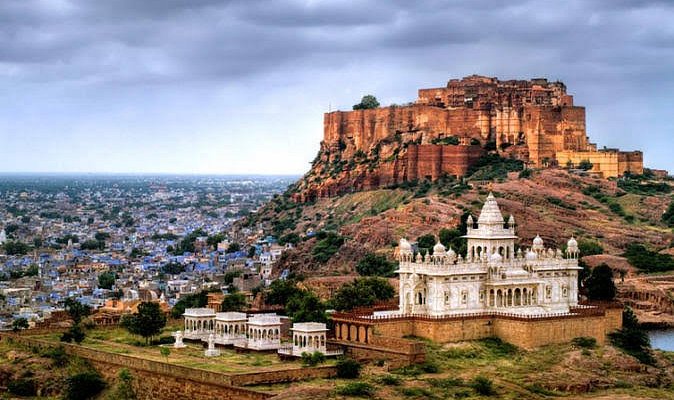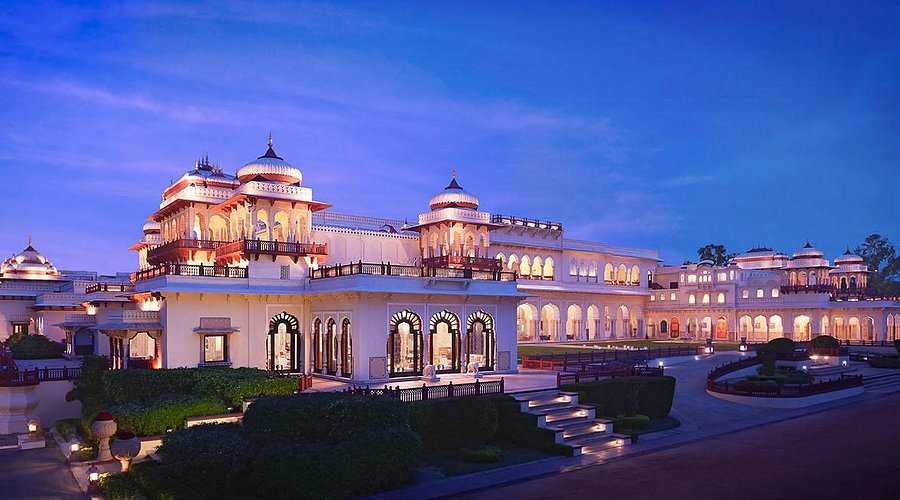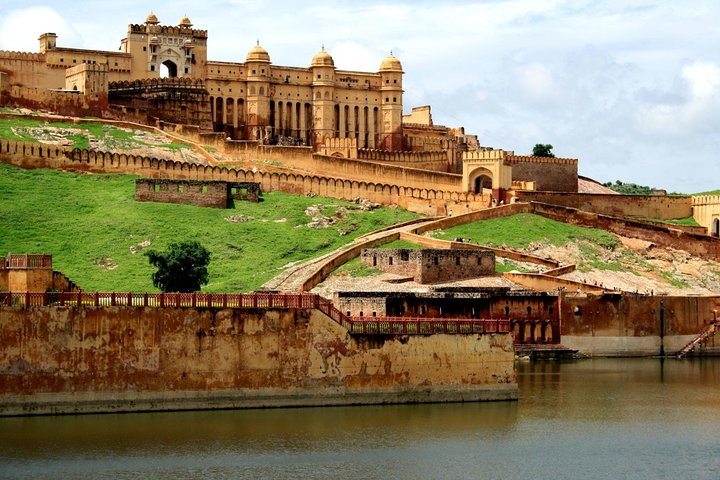Walled palaces in India stand as powerful reminders of the country’s rich history and strategic architectural design.
Exploring the top five walled palaces reveals the blend of artistry and protective elements that defined royal living in India. Each palace offers insight into the cultural and historical significance of its era, showcasing the skill and vision of its builders.
5) Mehrangarh Fort, Jodhpur

Mehrangarh Fort stands on a hill 400 feet above Jodhpur, Rajasthan, offering a commanding view of the city below. Built in 1459 by Rao Jodha, it is among the largest forts in India and features massive walls that emphasize its defensive purpose.
The fort spans over 1,200 acres and includes intricately carved palaces, courtyards, and museums. Its architecture reflects the strength and heritage of the Rathore rulers.
Mehrangarh is also known as the “Citadel of the Sun” and remains a significant cultural site. It attracts visitors interested in history, architecture, and the legacy of Rajasthan’s royal families.
4) Rambagh Palace, Jaipur

Rambagh Palace is located about 8 kilometers outside Jaipur’s city walls on Bhawani Singh Road. Originally built in 1835 as a garden house for King Ram Singh’s wet nurses, it was later expanded into a royal residence by Maharaja Sawai Man Singh II.
The palace covers 47 acres and combines grand architecture with luxurious interiors. It features marble corridors, opulent suites, and regal decor that reflect Jaipur’s royal heritage.
Today, Rambagh Palace operates as a luxury heritage hotel under Taj Hotels. It has hosted distinguished guests and offers visitors a glimpse into Rajasthan’s aristocratic past while providing modern facilities.
3) City Palace, Udaipur

The City Palace in Udaipur is a prominent example of a walled palace complex built on the eastern banks of Lake Pichola. It features a massive facade stretching over 240 meters and towers about 30 meters high.
Constructed starting in 1559 by Maharana Udai Singh II, the palace grew over nearly 400 years. It reflects a mix of Rajput, Mughal, and European architectural styles.
The complex served both as a royal residence and a fortress, strategically positioned on a ridge for defense. Its walls and fortifications showcase its military and cultural significance in Rajasthan’s history.
2) Amber Palace, Jaipur

Amber Palace, also known as Amer Fort, is located in Amer, 11 kilometers from Jaipur, Rajasthan’s capital. It sits atop a small hill, overlooking the town below.
The palace is built with pale yellow and pink sandstone combined with white marble. Its architecture reflects a blend of Rajput and Mughal styles.
Visitors can explore its ornate courtyards, grand gateways, and intricate mirror work. The palace is a UNESCO World Heritage Site and remains a key symbol of Rajasthan’s royal history.
1) Kumbhalgarh Fort, Rajasthan

Kumbhalgarh Fort is a 15th-century fortress located in the Aravalli Hills of Rajasthan. It was built by Rana Kumbha and is known for its massive wall stretching over 36 kilometers. This wall is the second-longest continuous fortification in the world, after the Great Wall of China.
The fort sits on a hill surrounded by 13 peaks, offering strategic defense and panoramic views. Inside, it houses numerous temples and palaces reflecting Mewar architecture. It is also a UNESCO World Heritage Site, part of the group known as the Hill Forts of Rajasthan.
Kumbhalgarh Fort remains a significant example of military architecture and royal heritage in India. It draws visitors interested in history, architecture, and Rajasthan’s cultural legacy.
Architectural Features of Walled Palaces
Walled palaces in India showcase a blend of military strength and refined aesthetics. Their design reflects both the need for protection and the desire for royal grandeur. Key elements include robust defensive systems, carefully planned interior spaces, and rich decorative work.
Defensive Structures and Fortifications
Walled palaces often feature thick, high walls made from stone or brick, designed to withstand attacks. These walls include battlements, parapets, and embrasures for archers and artillery. Large gates reinforced with iron or wood act as primary security points, often guarded by robust gatehouses.
Many palaces incorporate moats, drawbridges, and watchtowers to deter invaders. The strategic location of these structures, such as on hills or near rivers, enhances natural defense. Internal passages and secret exits provided escape routes and safe communication within the complex.
Courtyards and Gardens
Courtyards serve as central open spaces that facilitate airflow and light. They often connect different wings of the palace and host public ceremonies or private gatherings. Some palaces have multiple courtyards varying in size and function, reflecting their architectural complexity.
Gardens within walled palaces merge nature with human design, offering tranquility and visual delight. Features like fountains, symmetrical planting, and water channels draw influence from Persian and Mughal styles. These green areas contribute to cooling the environment and provide leisure space for royalty.
Ornamental Details and Artistry
Ornamentation in walled palaces balances grandeur with intricate craftsmanship. Facades exhibit detailed stone carvings, jali screens, and frescoes depicting mythological and royal themes. Interiors are often adorned with mirror work, painted ceilings, and decorative arches.
Materials like marble, sandstone, and wood are finely worked to highlight aesthetic appeal without compromising structural integrity. Stained glass windows, sculpted pillars, and ornate doorways further enhance the palace’s regal atmosphere, reflecting a fusion of cultural influences such as Rajput, Mughal, and Indo-Saracenic styles.
Cultural Significance and Historical Context
Walled palaces in India serve as tangible connections to the country’s royal past. Their design and function reveal the importance of authority, culture, and local traditions in shaping historical narratives.
Royal Heritage and Patronage
These palaces were centers of royal power and governance. Built under the patronage of kings and emperors, they often reflected the ruler’s wealth and vision. The construction showcased advanced craftsmanship and architectural styles unique to their era.
Royal families used these structures as residences, administrative hubs, and symbols of their ruling legitimacy. Patronage extended beyond construction to art and culture, with many palaces housing collections of paintings, manuscripts, and artifacts. This legacy underscores the role of monarchy in preserving and promoting regional art forms.
Events and Ceremonies
Walled palaces hosted crucial state occasions such as coronations, diplomatic meetings, and festivals. These ceremonies reinforced the ruler’s status and the kingdom’s stability. The courtyards and halls were designed to accommodate large gatherings, reflecting their official and social importance.
Religious rituals were also integral, often held in palace temples or dedicated sections. These events blended spiritual and political authority, emphasizing the ruler’s divine right. Palaces served as venues for traditional performances and cultural displays, fostering a sense of collective identity among subjects.
Role in Regional Identity
Each palace carries distinct regional architectural elements, reflecting local materials, climate, and craftsmanship. This uniqueness reinforces the cultural identity of its region and community. The preservation of these sites helps sustain local heritage and promotes tourism.
Palaces often symbolize regional pride and historical continuity. They serve as reminders of local dynasties’ resilience and influence. By embodying shared history, these structures contribute to a community’s collective memory and cultural cohesion.